The Canadian debut of Sony's QRIO robots | |
 |
Saturday, September 17, 2005 Ontario Science Centre I took my son, Joe, and daughter, Riese, to see Sony's Qrio. It was an amazing robot. Sony has clearly upped the bar with this biped. Thanks to Steve Jones for providing the tickets! Update on 01-2006: Sony has announced that Qrio development is being ceased. We are very fortunate to have seen this robot in person. |
Basic facts:
- Height: 58 cm- Weight: 7 kg
- Step height of up to 1 cm
- Can handle inclines of up to 10-15 degrees
Motion:
Qrioís movements are very impressive. It has 38 separate motors, 10 dedicated for the hands. All ten fingers are independently actuated. Being used to noisy hobby gear-motors, I was very surprised at how quiet Qrioís movements are. When it moves, you do not hear any of the normal robotic sounds.
Software:
OPEN-R is used to program Qrio. This is the same software that runs on Aibo. An onboard memory stick in Qrioís chest runs the OPEN-R autonomous code. There were only a couple demonstrations of Qrio operating autonomously. These included soccer, face and voice tracking, and getting up after being pushed over.
Mostly, Qrioís high-level control and motion sequences come from a nearby computer via a wireless LAN link. While not mentioned during the presentation, Sony is building a super-computer with around 250 nodes, capable of Tereflops-level performance. By linking Qrio to this computer, Sony can experiment with advanced AI.
Hardware:
Sony has called Qrio it's "technology platform." It was to be expected, therefore, that the presentation mentioned that Qrio uses several off-the-shelf components. A Sony Memory Stick in the chest holds the main program. The wireless connection is the same as Aiboís, and so on. Qrio also has a remote control mounted near its hands, presumably for interacting with Sony entertainment systems.
Control:
Qrio has three RISC processors:
- Motor control (Intelligent Servo Actuator or ISA)- Sound Localization and Recognition
- Vision
The Intelligent Servo Actuator (ISA) processor and subsystem controls some 38 motors thru out Qrioís body. The ISA provides low-level autonomous control, such as joint positioning and continuous automatic rebalancing. As Qrio put it, "If my arms go to the right, the lower part of my body has to make up for the weight by moving slightly to the left." In effect, Qrio bends at the hips to counter-act the shifting weight.
Sound localization is achieved by an independent RISC processor and seven microphones spaced evenly around the head. The demonstration was the presenter calling to Qrio. The robot then would locate and turn towards the presenter.
Vision appears to be basic face and shape recognition. Qrio uses its hand for color matching prior to performing the demonstrations. The CMUcam color system works similarly, but using its own hand is a nice touch.
There were two video demonstrations, one where Qrio tracked and kicked a soccer ball and another where Qrio tracked the presenterís face. During these, the overhead video briefly showed what Qrio "saw". Light is bad in the Imperial Oil Room. Thus I was not overly surprised when the video feed showed almost a pitch black screen with slightly colored areas representing either the pink soccer ball or the presenterís face.
Power:
Qrioís power is a 12V Lithium Ion pack. After the presentation, the crew ushered us out saying that they needed time to recharge Qrio before the next show. A show-time of thirty minutes and two hours between shows gives some indication of battery life. On Sonyís website, the runtime is around 1 hour.
Some miscellaneous thoughts:
The dancing was fun to watch and looked life-like. Part of this was the deliberate addition of mistakes. For instance, when two Qrios dance they are slightly out of sync with each other. This makes it look more natural, as we humans are used to seeing people who move slightly different though synchronized. The other humanizing touch was that, after the dances, the Qrios bounced slightly, mimicking the look of a person heavily breathing after a strenuous dance. Itís amusing that the engineers had to add human weaknesses to make the movements seem more realistic.
While I enjoyed the overall presentation, I had a nagging shadow of doubt in the back of my mind. When the Qrioís eyes briefly glowed red, I realized what it was. The robots are, well, vaguely disquieting. I asked my son and daughter if they felt the same way. They said that they did not. Perhaps itís just because I have watched one too many robot horror movies?
Of course, it did not help matters much that one of the Qrios squeaked "No disassemble!" when the engineers took it off stage. (grin)
Videos:
- Qrio Introduces Itself (36 MB)- Qrio Performs Tai Chi (15 MB)
Photographs:
My apologies for the low quality of these photographs. The presentation was in the Imperial Oil Room, which has unique lighting. I had a difficult time adjusting my new camera, and so all of the photographs were a bit blurry.
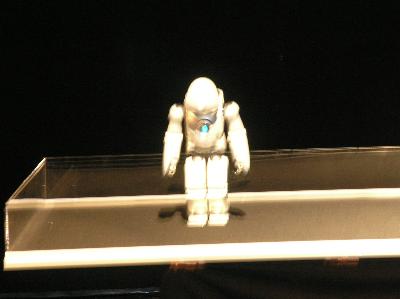
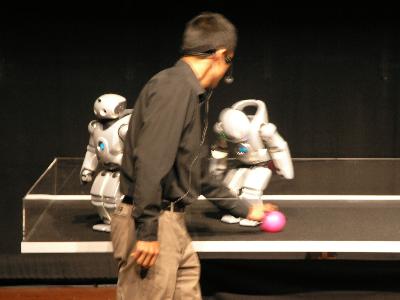
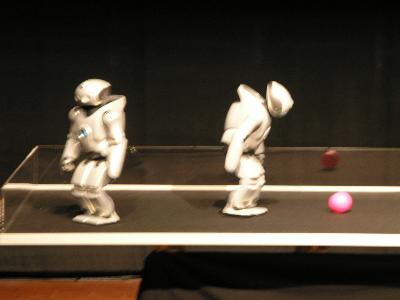
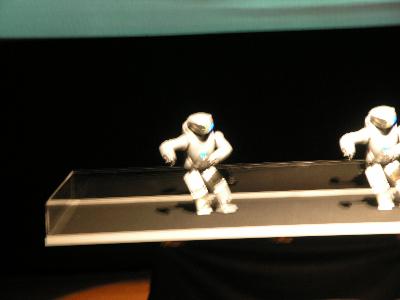
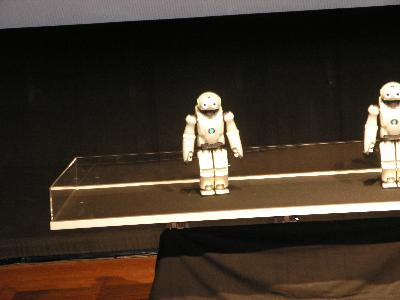
Hmmm, perhaps increasing the exposure time will help? Nope.
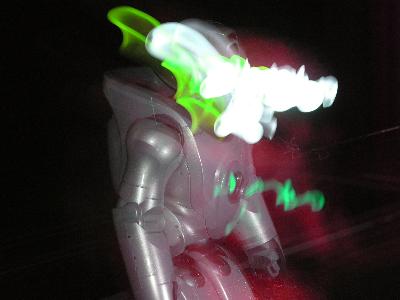
A Brief History:
Sony built the first Sony Dream Robot (SDR) in the late 1990s. In 2000, the SDR-3X debuted at Robodex. Subsequent SDRs were built, leading to the Sony Qrio in 2004. In January of 2005, Sony announced it was stopping research and development on both Qrio and Aibo.
Sony SDR-3 (Courtesy of Sony)
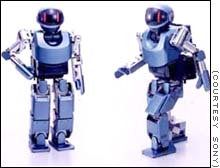
Sony SDR-3X, Debuted at Robodex 2000
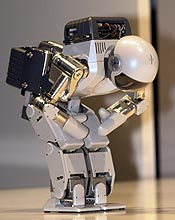
Sony SDR-4
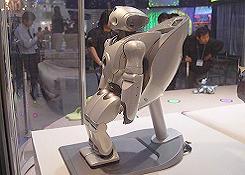
Sony SDR-4X (Courtesy of Sony)

Sony QRIO 1 (Courtesy of Sony)
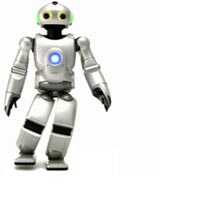
Related Links:
- Sony Qrio- Sony OPEN-R Software
- Ontario Science Centre